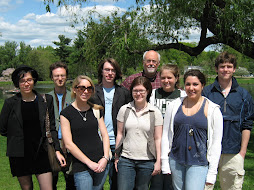By Gregory Hebert and Rafal Wilson
Art Talmadge and Sherry Simpson are living proof that sustainable agriculture is possible in places as close as your back yard—because that’s where their own farm is. Seven years of hard work has demonstrated that achieving this dream is not easy, however.
Cranberry Hill Farm, which the couple bought in 2002, is located on 30 acres in Ashford, Conn. They do more than just grow and sell food, though—they’re responsible for founding the Ashford Farmer’s Market that runs from June to October and in order to protect their farm and others they are becoming increasingly active in local politics.
For decades small farms in Connecticut and elsewhere have been suffering a slow death. Buoyed by the movement to buy local food, small farms such as Cranberry Hill may be a sign that Connecticut agriculture may still survive.
"You name it, we grow it," said Talmadge, a University of Connecticut graduate who was a natural resource management major. Their soil yields a multitude of vegetables, including peas, onions, spinach, radishes, beets, carrots, and three varieties of lettuce.
Simpson and Talmadge take pride in the fact that they only use heirloom vegetables and heritage animals, although their only livestock breed is chickens. Simpson said that most farmers across the country only use one kind of animal and crop, which, while good for production, has resulted in things like Thanksgiving turkeys incapable of mating on their own, chickens that do not know how to take care of their own eggs, and extreme vulnerability to diseases.
Cranberry Hill Farm, on the other hand, has three varieties of tomatoes, all of which Simpson says are more flavorful than what can be found in local supermarkets. The trade-off is that some crops such as the tomatoes are too fragile to transport across the country like standard supermarket crops. Also, the eggs produced by her chickens are not USDA certified.
"When thinking about planning and sustainability, you have to think about what you produce and what you bring in," said Talmadge. Two years ago Cranberry Hill Farm experienced a drought while last year the growing season was far too wet. Their squash crop was also damaged when they brought in some compost from an outside location. Squash bugs in the compost ruined the crop, forcing them this year to prepare a new bed that is several acres away.
The Cranberry Hill Farm owners also have high hopes for seeing what they can do in animal husbandry. Today they have around a dozen Dominique chickens, but they hope to expand to hogs and possibly even cattle some day.
Talmadge pointed to a 100-square-foot clearing that took him almost three years to open and said he wished he would have had the hogs. "Hogs could have done this for us," said Talmadge.
The reason they have been slow to get new animals is because of their concern for the well being of the livestock. "The humane raising of animals is key to this farm," said Talmadge. According to Simpson, they would like the chickens to be free range but they have to worry about foxes, coyotes, and a hawk, the last of which snatched up a chicken the other day.
Having truly free-range chickens would require they buy ten times the amount they have now in order to achieve price sustainability. As it is, they usually try to time their schedules so they can watch over the chickens. Further, Talmadge said that they don’t keep hogs and sheep due to the fact that the local slaughterhouse practices—which require the animals to be driven several hours away before being killed—does not fit into their definition of humane.
A short hike into the woods reveals a ridge overlooking wetlands that began life as a man-made pond. "We are very aware that people drink this and appreciate its value," said Talmadge. The wetland feeds into what becomes the drinking water source for Willimantic. The wetland is also home to the farm’s namesake Native American cranberries, which are left alone to feed the wildlife living in the area.
On the far side of the farm, through the woods, is a field. Talmadge estimated that he could grow around six to eight acres of hay. But some of the pasture has been plowed up to create two 100 foot by 50 foot plots. While the new beds could produce more needed vegetables, they do not have any dedicated water source. "This is where we'll be doing a lot of rain dances, I think," joked Talmadge.
Talmadge is also setting up a maple syrup tapping system from the many sugar maples in the woods around the farm. To help the maples grow, other trees are being felled to provide a sizable firewood crop that could sustain the couple through the winter. “When I was first out of work,” said Talmadge, who lost his full-time job in February, “I thought to myself, ‘I need to get some firewood on the ground.’”
“You have to look at every potential side of the equation, and there’s far too many sometimes,” said Talmadge.
Tuesday, May 26, 2009
Subscribe to:
Post Comments (Atom)

No comments:
Post a Comment